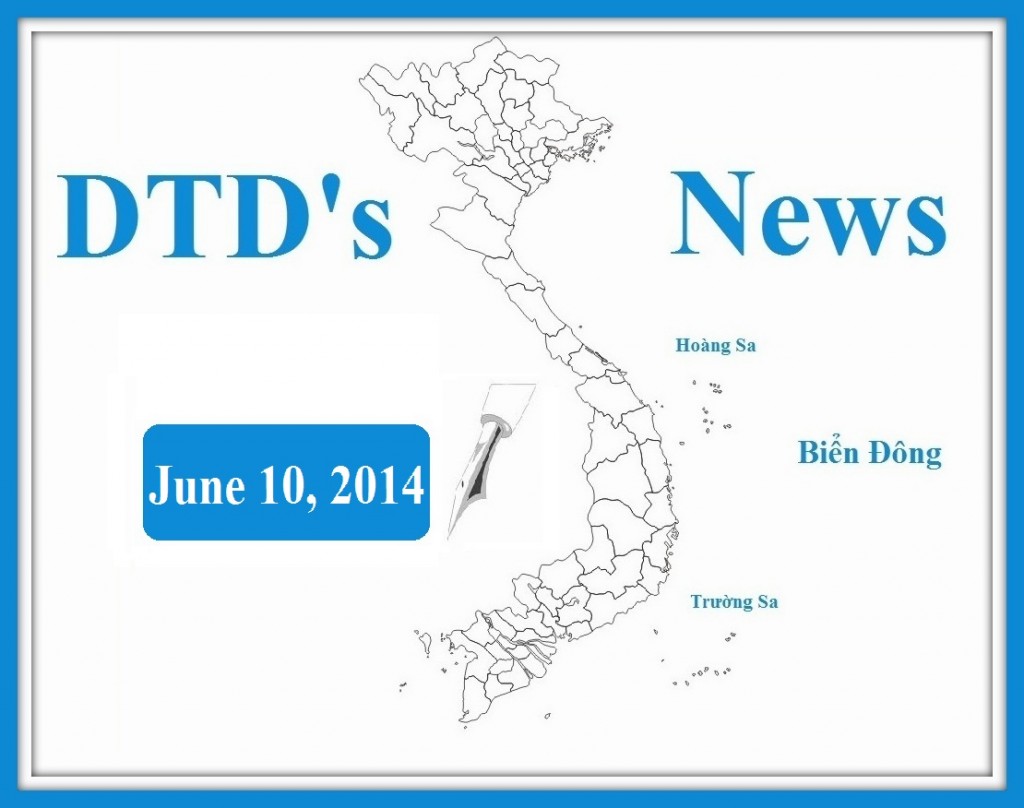
Defend the Defenders | June 10, 2014
Vietnam has slammed China for its deployment of $1 billion drilling platform and an escort flotilla of ships, including warships in Vietnam’s exclusive economic zone in the Senior Officials’ Meeting of the ASEAN Regional Forum (SOM ARF) which opened in Myanmar on June 9.
Speaking at the meeting with the participation of senior officials from 27 ARF countries, the European Union and the ASEAN Secretariat, Vietnamese Deputy Minister of Foreign Affairs Pham Quang Vinh said the Chinese provocative actions not only violate Vietnam’s sovereignty, but also affect peace and stability as well as freedom of international navigation in the East Sea.
The Chinese aggressive moves aim to assert China’s illegal sovereignty claims of 90% of waters of the East Sea, he noted, adding that the moves seriously infringed international law and the 1982 UN Convention on the Law of the Sea (UNCLOS), he noted.
Vietnam requests China to immediately withdraw the oil rig and all of its ships out of Vietnam’s waters, he said.
Vinh called on China to abide by international law, the UNCLOS 1982, and DOC regulations, while stressing the urgent need to soon build the formal code of conduct (COC) to ensure peace, stability, security and safety of navigation in the East Sea.
Officials from 27 ARF countries, the European Union and the ASEAN Secretariat raised their deep concerns about the escalating tension in the Ease Sea.
They underscored the need to practice restraint while strongly condemning unilateral moves that infringe international law, the UNCLOS and the Declaration on the Conduct of Parties in the East Sea (DOC).
They urged the ASEAN and China to work towards the formation of a Code of Conduct in the East Sea to replace the unbinding DOC. (Vietnam Panorama June 10)
Vietnam PM Should Present East Sea Issues in NA Interpellation: Lawmaker
Vietnamese Prime Minister Nguyen Tan Dung should take part in a question-and-answer session of the country’s legislative body National Assembly (NA) to update lawmakers about the East Sea issues, said Duong Trung Quoc, deputy of the assembly.
The government leader has made strong voice against China’s deployment of $1 billion HYSY-981 drilling platform and an escort flotilla of ships within Vietnam’s exclusive economic zone in the East Sea so his presentation before the parliament should have a strong impact on the domestic public and the global community, said Mr. Quoc, who is also a historian expert.
Earlier, Mr. Quoc urged other Vietnamese senior leaders to slam the Chinese aggressive moves in the East Sea.
Four ministers of the Vietnamese government are scheduled to participate in the interpellation of the ongoing month-long session.
PM Dung has received support from Vietnamese people at home and abroad after condemning the Chinese violations of the country’s sovereignty by saying that Vietnam would make all effort to protect the country’s territory, and the country will not exchange any interest with unreliable friendship.
Condemning the Chinese unilateral actions in the East Sea, PM Dung threatened to use legal action to challenge Beijing’s expansionism to the international court.
President Truong Tan Sang and Chairman Nguyen Sinh Hung of the assembly also expressed grave concerns about the tension at a lower extent, while General Secretary of the Communist Party of Vietnam Nguyen Phu Trong remained rather silent, possibly for fears of hurting Beijing, observers said.
Local observers raised concerns about the situation as Chinese contractors accounted for 80%-90% of Vietnam’s engineering-procurement-construction deals for national infrastructure development projects as of 2010. Chinese contractors are blamed for the sluggish implementation of 30 projects local observers said that they may use outdated technologies and equipment, and bring thousands of untrained compatriots, instead of hiring local workers. Mr. Dung took office for the first term in 2006.
The bilateral trade jumped over ten-fold from 2006 to $50 billion in 2013, with Vietnam’s trade deficit with China widening and hitting over $24 billion last year, the government’s data.
PM Dung was the person who approved Chinese contractors to implement the bauxite mining projects in Vietnam’s Central Highlands.
After being elected to the current post in 2007, Dung promised to deal with corruption. Now corruption has remained rampant and systematic, which threatens the country’s economy and degrades the morals.
Due to failure to cope with rampant corruption and economic mismanagement, Dung’s prestige has been strongly hurt, observers said. However, he refused to resign, saying he always obeys the duty assigned by the communist party. (Vietnam Panorama June 10)
Vietnam, Italy to Raise Bilateral Trade to $5B, Concerned about East Sea
Vietnam and Italy have agreed to beef up the multi-faceted cooperation, including expanding the bilateral trade to $5 billion in the next two years from $3.5 billion last year while expressing grave concerns about the tension in the East Sea, Vietnamese state media reported on Tuesday.
The consensus was made at a meeting in Hanoi on June 9 between Vietnamese Prime Minister Nguyen Tan Dung and his Italian counterpart Matteo Renzi, who is visiting the communist nation on June 9-10.
The two countries pledged to seek ways to strengthen connectivity between their businesses while enhancing partnership in all fields, including apparel, footwear, supporting industry, construction materials, energy and food processing.
The two sides pledged to maintain strategic dialogues at a deputy minister-level and set up an inter-governmental committee on economic cooperation with its first meeting slated for November this year.
The two government leaders are committed to boosting cooperation between universities from the two countries and establishing a Vietnam-Italy excellence research center.
Vietnam and Italy will closely coordinate at international organizations and at multilateral forums, including the UN, ASEAN-EU and Asia-Europe Meeting.
PM Renzi affirmed that Italy shares the EU and G7 Group’s viewpoint that G7 nations are deeply concerned about the escalating tension in the sea and wants all sides to exercise their utmost restraint and solve disputes through peaceful measures by international law.
On the same day, PM Renzi paid courtesy visits to President Truong Tan Sang and General Secretary of the Communist Party of Vietnam Nguyen Phu Trong.
The visit of Mr. Renzi is the first made by an Italian prime minister since the two countries set up their diplomatic ties in 1973. Last year, the two countries elevated their diplomatic relations to strategic partnership. (Vietnam Panorama June 10)
India’s Enhanced Presence Helps Stabilize ASEAN: Vietnam Ambassador
India’s increased presence in the Southeast Asia will help stabilize the region amid escalating tensions in the East Sea after China parked its oil drilling rig in the sea in early May, Vietnamese Ambassador to New Delhi Nguyen Thanh Tan has said.
India’s involvement in the region through its dynamic Look East Policy is expected to balance the rise of China, Mr. Tan said in an interview with India’s Economic Times on June 9, adding that all countries in the region have the same desires.
Being India’s closest partner in the ASEAN region, Vietnam has seen stronger investment inflows from India over the past years and the Southeast Asian country remains potential and available for Indian investment, Mr. Tan said.
Laid ground by late President Ho Chi Minh and late Prime Minister Jawaharlal Nehru in the 1950s, the close friendship relationship has brought the two countries closer in economic and defense ties.
Over the past years, India has invested in Vietnam’s power, oil and gas industries through hydrocarbon blocks off the country’s coastline in the East Sea, where China claims nearly 90%. Currently, Indian Tata Group is investing in a $2 billion thermal power project in southern Vietnam while other big Indian investors are mulling over operation in steel manufacturing.
The two countries are expected to launch direct flights from India to Vietnam and vice versa from late this year to early 2015 to serve the traveling of roughly 500,000 Indian visitors to Vietnam annually.
Calling India a “benign power”, Mr. Tan said he hopes that Prime Minister Narendra Modi will pursue a robust Look East Policy following the footsteps of his predecessors.
The diplomat also thanked India for support to Vietnam during the Vietnam-China border clash in 1979 and highlighted the long-lasting multi-faceted relationship.
The Vietnam – India relations have warmed up over the past years and Hanoi expects the bilateral ties to deepen in efforts to seek support and cooperation with powerful countries after China moored the $1-billion oil rig within Vietnam’s exclusive economic zone in the East Sea.
In 2013, trade between Vietnam and India rose 32.82% on year to $5.23 billion. (Vietnam Panorama June 10)
Myanmar Hosts Meetings on Lower Mekong Ahead of MRC Summit
Senior officials of Cambodia, Laos, Myanmar, Thailand and Vietnam on June 8 met with those from the U.S. to discuss sustainable economic growth in the Mekong sub-region in Yangon, three weeks ahead of the Mekong River Commission (MRC)’s Summit in Thailand.
The Lower Mekong Initiative (LMI) SOM meeting, which involves the five Mekong countries and the U.S., touched upon cooperation for the next five years and preparation for the 7th LMI foreign ministerial meeting.
Participants acknowledged significance of the initiatives in the region, saying a number of projects on the environment and water, health care, education, connectivity, energy security, agriculture and food security have been successfully implemented.
At the Friends of Lower Mekong (FLM) SOM meeting, delegates reaffirmed their plan to increase connection with the Mekong sub-region countries and narrow development gaps and support the settlement of common challenges in the region.
They agreed to make sustainable development as the topic of LMI and FLM foreign ministerial meetings to be held in Myanmar’s capital city of Nay Pyi Taw in August.
The FLM includes the five Mekong sub-region countries, the U.S., Japan, South Korea, Australia, New Zealand, the EU.
Ministers from Laos, Cambodia, Thailand, and Vietnam will meet on June 26-27 in Thailand to discuss whether Laos should be required to consult its neighbors before moving ahead with a second controversial dam named Don Sahong on the regional waterway.
Laos’s neighbors have raised concerns about the trans-boundary impact of the 260-megawatt project, which is to be built just north of the Cambodian border.
They insisted that it should be put through a formal consultation and technical assessment while Laos has maintained that it should go through MRC procedures that require Vientiane only to provide neighbors information about the project.
Following disagreement over the procedures at a lower-level MRC meeting in January, the water and environment ministers of Laos, Cambodia, Thailand and Vietnam who make up the MRC Council will take up the issue at this month’s meeting.
Laos is building Xayaburi dam despite strong protest from Vietnam and Cambodia as the communist government in Vientiane wants to turn the country in energy exporter. (Vietnam Panorama June 10)
Vietnam Parliament OKs $751M for Waters, Islands Sovereignty Protection
Vietnam’s National Assembly on June 9 agreed to spend VND16 trillion ($751 million) to support the country’s law enforcement forces and fishermen in a bid to step up the sovereignty protection of the country’s islands and waters in the East Sea, state media reported.
The money will go to the Vietnam Coast Guard, the Vietnam Fisheries Resources Surveillance Force and fishermen, which will use to purchase equipment for patrol and build offshore fishing vessels.
The money will be sourced from the country’s budget expenditure in the fiscal year of 2013, according to a resolution adopted in the afternoon session.
The Vietnam Coast Guard and the Vietnam Fisheries Resources Surveillance Force are the forces confronting against China’s deployment of Haiyang Shiyou-981 drilling platform and the escort flotilla of over one hundred ships in Vietnam’s exclusive economic zone.
Since May 1 China’s ships have attacked Vietnamese vessels with ramming, firing powered water cannon and throwing stones. 24 Vietnamese ships were heavily damaged and 12 crews were seriously injured from the Chinese attacks. Chinese ships have attacked 12 Vietnamese fishing boats, sinking one ship and killing one farmer, according to Vietnam’s government.
Vietnam has encouraged fishermen in the central provinces to go offshore fishing near Hoang Sa (Paracels), the Vietnamese archipelagoes which are under China’s occupation. However, Vietnamese fishermen are facing harassments from China’s authorities.
Currently, Vietnam and China have overlapping sovereignty claims over Hoang Sa. The two countries, together with Malaysia, the Philippines and Taiwan claim entirely or partly Truong Sa (Spratlys) in the East Sea.
In recent years, China has had aggressive behaviors in a bid to assert its claims of nearly the entire East Sea, including Hoang Sa and Truong Sa, the two archipelagos that Vietnam has peacefully administered since the 17th century, and the Filipino Scarborough Shoal and surrounding waters. (Vietnam Panorama June 10)
Height Insoles: Hi, I do believe this is an excellent site. I stumbledupon …
http://fishinglovers.net: Appreciate you sharing, great post.Thanks Again. Keep writi…
Achilles Pain causes: Every weekend i used to pay a quick visit this site, as i w…

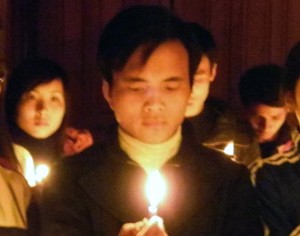
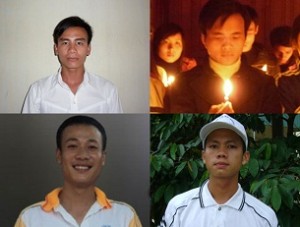
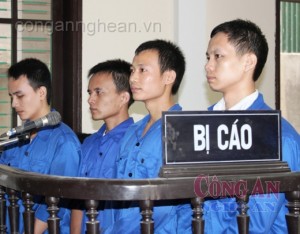

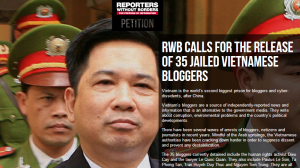
June 11, 2014
DTD’s Vietnam News: Vietnam Protests China’s Deployment of Oilrig, Warships at ARF Meetings
by HR Defender • [Human Rights]
Defend the Defenders | June 10, 2014
Vietnam has slammed China for its deployment of $1 billion drilling platform and an escort flotilla of ships, including warships in Vietnam’s exclusive economic zone in the Senior Officials’ Meeting of the ASEAN Regional Forum (SOM ARF) which opened in Myanmar on June 9.
Speaking at the meeting with the participation of senior officials from 27 ARF countries, the European Union and the ASEAN Secretariat, Vietnamese Deputy Minister of Foreign Affairs Pham Quang Vinh said the Chinese provocative actions not only violate Vietnam’s sovereignty, but also affect peace and stability as well as freedom of international navigation in the East Sea.
The Chinese aggressive moves aim to assert China’s illegal sovereignty claims of 90% of waters of the East Sea, he noted, adding that the moves seriously infringed international law and the 1982 UN Convention on the Law of the Sea (UNCLOS), he noted.
Vietnam requests China to immediately withdraw the oil rig and all of its ships out of Vietnam’s waters, he said.
Vinh called on China to abide by international law, the UNCLOS 1982, and DOC regulations, while stressing the urgent need to soon build the formal code of conduct (COC) to ensure peace, stability, security and safety of navigation in the East Sea.
Officials from 27 ARF countries, the European Union and the ASEAN Secretariat raised their deep concerns about the escalating tension in the Ease Sea.
They underscored the need to practice restraint while strongly condemning unilateral moves that infringe international law, the UNCLOS and the Declaration on the Conduct of Parties in the East Sea (DOC).
They urged the ASEAN and China to work towards the formation of a Code of Conduct in the East Sea to replace the unbinding DOC. (Vietnam Panorama June 10)
Vietnam PM Should Present East Sea Issues in NA Interpellation: Lawmaker
Vietnamese Prime Minister Nguyen Tan Dung should take part in a question-and-answer session of the country’s legislative body National Assembly (NA) to update lawmakers about the East Sea issues, said Duong Trung Quoc, deputy of the assembly.
The government leader has made strong voice against China’s deployment of $1 billion HYSY-981 drilling platform and an escort flotilla of ships within Vietnam’s exclusive economic zone in the East Sea so his presentation before the parliament should have a strong impact on the domestic public and the global community, said Mr. Quoc, who is also a historian expert.
Earlier, Mr. Quoc urged other Vietnamese senior leaders to slam the Chinese aggressive moves in the East Sea.
Four ministers of the Vietnamese government are scheduled to participate in the interpellation of the ongoing month-long session.
PM Dung has received support from Vietnamese people at home and abroad after condemning the Chinese violations of the country’s sovereignty by saying that Vietnam would make all effort to protect the country’s territory, and the country will not exchange any interest with unreliable friendship.
Condemning the Chinese unilateral actions in the East Sea, PM Dung threatened to use legal action to challenge Beijing’s expansionism to the international court.
President Truong Tan Sang and Chairman Nguyen Sinh Hung of the assembly also expressed grave concerns about the tension at a lower extent, while General Secretary of the Communist Party of Vietnam Nguyen Phu Trong remained rather silent, possibly for fears of hurting Beijing, observers said.
Local observers raised concerns about the situation as Chinese contractors accounted for 80%-90% of Vietnam’s engineering-procurement-construction deals for national infrastructure development projects as of 2010. Chinese contractors are blamed for the sluggish implementation of 30 projects local observers said that they may use outdated technologies and equipment, and bring thousands of untrained compatriots, instead of hiring local workers. Mr. Dung took office for the first term in 2006.
The bilateral trade jumped over ten-fold from 2006 to $50 billion in 2013, with Vietnam’s trade deficit with China widening and hitting over $24 billion last year, the government’s data.
PM Dung was the person who approved Chinese contractors to implement the bauxite mining projects in Vietnam’s Central Highlands.
After being elected to the current post in 2007, Dung promised to deal with corruption. Now corruption has remained rampant and systematic, which threatens the country’s economy and degrades the morals.
Due to failure to cope with rampant corruption and economic mismanagement, Dung’s prestige has been strongly hurt, observers said. However, he refused to resign, saying he always obeys the duty assigned by the communist party. (Vietnam Panorama June 10)
Vietnam, Italy to Raise Bilateral Trade to $5B, Concerned about East Sea
Vietnam and Italy have agreed to beef up the multi-faceted cooperation, including expanding the bilateral trade to $5 billion in the next two years from $3.5 billion last year while expressing grave concerns about the tension in the East Sea, Vietnamese state media reported on Tuesday.
The consensus was made at a meeting in Hanoi on June 9 between Vietnamese Prime Minister Nguyen Tan Dung and his Italian counterpart Matteo Renzi, who is visiting the communist nation on June 9-10.
The two countries pledged to seek ways to strengthen connectivity between their businesses while enhancing partnership in all fields, including apparel, footwear, supporting industry, construction materials, energy and food processing.
The two sides pledged to maintain strategic dialogues at a deputy minister-level and set up an inter-governmental committee on economic cooperation with its first meeting slated for November this year.
The two government leaders are committed to boosting cooperation between universities from the two countries and establishing a Vietnam-Italy excellence research center.
Vietnam and Italy will closely coordinate at international organizations and at multilateral forums, including the UN, ASEAN-EU and Asia-Europe Meeting.
PM Renzi affirmed that Italy shares the EU and G7 Group’s viewpoint that G7 nations are deeply concerned about the escalating tension in the sea and wants all sides to exercise their utmost restraint and solve disputes through peaceful measures by international law.
On the same day, PM Renzi paid courtesy visits to President Truong Tan Sang and General Secretary of the Communist Party of Vietnam Nguyen Phu Trong.
The visit of Mr. Renzi is the first made by an Italian prime minister since the two countries set up their diplomatic ties in 1973. Last year, the two countries elevated their diplomatic relations to strategic partnership. (Vietnam Panorama June 10)
India’s Enhanced Presence Helps Stabilize ASEAN: Vietnam Ambassador
India’s increased presence in the Southeast Asia will help stabilize the region amid escalating tensions in the East Sea after China parked its oil drilling rig in the sea in early May, Vietnamese Ambassador to New Delhi Nguyen Thanh Tan has said.
India’s involvement in the region through its dynamic Look East Policy is expected to balance the rise of China, Mr. Tan said in an interview with India’s Economic Times on June 9, adding that all countries in the region have the same desires.
Being India’s closest partner in the ASEAN region, Vietnam has seen stronger investment inflows from India over the past years and the Southeast Asian country remains potential and available for Indian investment, Mr. Tan said.
Laid ground by late President Ho Chi Minh and late Prime Minister Jawaharlal Nehru in the 1950s, the close friendship relationship has brought the two countries closer in economic and defense ties.
Over the past years, India has invested in Vietnam’s power, oil and gas industries through hydrocarbon blocks off the country’s coastline in the East Sea, where China claims nearly 90%. Currently, Indian Tata Group is investing in a $2 billion thermal power project in southern Vietnam while other big Indian investors are mulling over operation in steel manufacturing.
The two countries are expected to launch direct flights from India to Vietnam and vice versa from late this year to early 2015 to serve the traveling of roughly 500,000 Indian visitors to Vietnam annually.
Calling India a “benign power”, Mr. Tan said he hopes that Prime Minister Narendra Modi will pursue a robust Look East Policy following the footsteps of his predecessors.
The diplomat also thanked India for support to Vietnam during the Vietnam-China border clash in 1979 and highlighted the long-lasting multi-faceted relationship.
The Vietnam – India relations have warmed up over the past years and Hanoi expects the bilateral ties to deepen in efforts to seek support and cooperation with powerful countries after China moored the $1-billion oil rig within Vietnam’s exclusive economic zone in the East Sea.
In 2013, trade between Vietnam and India rose 32.82% on year to $5.23 billion. (Vietnam Panorama June 10)
Myanmar Hosts Meetings on Lower Mekong Ahead of MRC Summit
Senior officials of Cambodia, Laos, Myanmar, Thailand and Vietnam on June 8 met with those from the U.S. to discuss sustainable economic growth in the Mekong sub-region in Yangon, three weeks ahead of the Mekong River Commission (MRC)’s Summit in Thailand.
The Lower Mekong Initiative (LMI) SOM meeting, which involves the five Mekong countries and the U.S., touched upon cooperation for the next five years and preparation for the 7th LMI foreign ministerial meeting.
Participants acknowledged significance of the initiatives in the region, saying a number of projects on the environment and water, health care, education, connectivity, energy security, agriculture and food security have been successfully implemented.
At the Friends of Lower Mekong (FLM) SOM meeting, delegates reaffirmed their plan to increase connection with the Mekong sub-region countries and narrow development gaps and support the settlement of common challenges in the region.
They agreed to make sustainable development as the topic of LMI and FLM foreign ministerial meetings to be held in Myanmar’s capital city of Nay Pyi Taw in August.
The FLM includes the five Mekong sub-region countries, the U.S., Japan, South Korea, Australia, New Zealand, the EU.
Ministers from Laos, Cambodia, Thailand, and Vietnam will meet on June 26-27 in Thailand to discuss whether Laos should be required to consult its neighbors before moving ahead with a second controversial dam named Don Sahong on the regional waterway.
Laos’s neighbors have raised concerns about the trans-boundary impact of the 260-megawatt project, which is to be built just north of the Cambodian border.
They insisted that it should be put through a formal consultation and technical assessment while Laos has maintained that it should go through MRC procedures that require Vientiane only to provide neighbors information about the project.
Following disagreement over the procedures at a lower-level MRC meeting in January, the water and environment ministers of Laos, Cambodia, Thailand and Vietnam who make up the MRC Council will take up the issue at this month’s meeting.
Laos is building Xayaburi dam despite strong protest from Vietnam and Cambodia as the communist government in Vientiane wants to turn the country in energy exporter. (Vietnam Panorama June 10)
Vietnam Parliament OKs $751M for Waters, Islands Sovereignty Protection
Vietnam’s National Assembly on June 9 agreed to spend VND16 trillion ($751 million) to support the country’s law enforcement forces and fishermen in a bid to step up the sovereignty protection of the country’s islands and waters in the East Sea, state media reported.
The money will go to the Vietnam Coast Guard, the Vietnam Fisheries Resources Surveillance Force and fishermen, which will use to purchase equipment for patrol and build offshore fishing vessels.
The money will be sourced from the country’s budget expenditure in the fiscal year of 2013, according to a resolution adopted in the afternoon session.
The Vietnam Coast Guard and the Vietnam Fisheries Resources Surveillance Force are the forces confronting against China’s deployment of Haiyang Shiyou-981 drilling platform and the escort flotilla of over one hundred ships in Vietnam’s exclusive economic zone.
Since May 1 China’s ships have attacked Vietnamese vessels with ramming, firing powered water cannon and throwing stones. 24 Vietnamese ships were heavily damaged and 12 crews were seriously injured from the Chinese attacks. Chinese ships have attacked 12 Vietnamese fishing boats, sinking one ship and killing one farmer, according to Vietnam’s government.
Vietnam has encouraged fishermen in the central provinces to go offshore fishing near Hoang Sa (Paracels), the Vietnamese archipelagoes which are under China’s occupation. However, Vietnamese fishermen are facing harassments from China’s authorities.
Currently, Vietnam and China have overlapping sovereignty claims over Hoang Sa. The two countries, together with Malaysia, the Philippines and Taiwan claim entirely or partly Truong Sa (Spratlys) in the East Sea.
In recent years, China has had aggressive behaviors in a bid to assert its claims of nearly the entire East Sea, including Hoang Sa and Truong Sa, the two archipelagos that Vietnam has peacefully administered since the 17th century, and the Filipino Scarborough Shoal and surrounding waters. (Vietnam Panorama June 10)